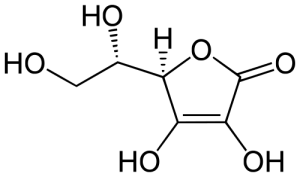Vitamin C or ascorbic acid in scientific terms is vital for our health and well-being. We need it to keep connective tissue like collagen strong so that it maintains the structural integrity of our organs and tissues. Without it we would suffer scurvy and lose our teeth for example or have sores which just do not heal. It also keeps our body’s cells in good order.

Chemical Name For Vitamin C
You might see it called a more chemical sounding name:- 2,3-didehydro-L-threo-hexonic acid-g-lactone. The vitamin is an acid derivative of a 6-carbon sugar. You can see in the structure it has a diol group at carbons-2 and 3 which allows it to act as a very powerful reducing agent.
Sources Of Vitamin C
The best sources of vitamin C are oranges and other citrus fruits, guava, kiwi fruit, blackcurrants, redcurrants, chilli peppers, green and red peppers, potatoes – especially the skins and green vegetables generally. What about cauliflower ? Apparently, its absolutely full of this vitamin. A balanced diet is really what is needed to maintain our intake.

The Key Functions Of Vitamin C
Vitamin C or ascorbic acid has the following general health benefits:-
Vitamin C And Heart Health
Vitamin C is believed to be associated with good cardiovascular health although this has come through association by the consumption of various fruits and vegetables (Joshipura et al., 2001; Homberg et al., 2009; Martinez-Gonzalez et al., 2011). These studies noted an inverse association existed between dietary vitamin C intake, the levels of ascorbic acid in plasma and various cardiovascular ris factors, heart disease and mortality (CVM). Such studies however have limitations and did not rule out other factors known to be of benefit such as fiber consumption for example.
It may simply be the case that a good balanced diet is more significant in maintaining and improving heart health.
How Much Do We Need ?
We cannot make vitamin C – something we share with trout and other primates, but which most other animals don’t have to worry about! We need 40 mg of this vitamin a day as we cannot store it. There is no universally recommended daily intake of vitamin C but the World Health Organisation recommends a daily intake of 30 mg and in the UK, the RDA is higher at 60 mg.
Vitamin C supplements need to be taken with care to avoid overdosing as too much, say over 1,000 mg/day, causes, flatulence, diarrhoea and stomach cramps.
We know for example that people who have suffered heart attacks (acute myocardial infarction) have much lower than normal plasma levels of vitamin C. (Hume et al., 1972; Machtey et al., 1975; Jaxa-Chamiec et al., 2005) Leukocytes are the main cells in the body which contains reserve of vitamin C.
Please note this page contains links to our affiliate marketing partners. We are an Amazon Associate. Please read our affiliate disclosure.
Legal Disclaimer Concerning Products On This Web-Site
The products and the information provided about specific products on or through this site have not been evaluated by the United States Food and Drug Administration or by any other national regulatory body and are not intended to diagnose, treat, cure or prevent disease. The information provided on this site is for informational purposes only and is not intended as a substitute for advice from your physician/doctor or other health care professional or any information contained on or in any product label or packaging. You should not use the information on this site for diagnosis or treatment of any health problems or for prescription of any medication or other treatment. You should consult with a healthcare professional before starting any diet, exercise or supplementation program, before taking any medication or if you suspect you might have a health problem.
References
Department of Health Report on Health and Social Science: Dietary Reference Values for Food, Energy and Nutrients for the United Kingdom. (1999) 41: pp. 37-43.
Holmberg, S.; Thelin, A.; Stiernström, E.L. (2009) Food Choices and Coronary Heart Disease: A Population Based Cohort Study of Rural Swedish Men with 12 Years of Follow-up. Int. J. Environ. Res. Public Health. 6, pp. 2626–2638.
Hume, R., Weyers, E., Rowan, T., Reia, D.S., Hillis, W.S (1972) Leucocyte ascorbic acid levels and acute myocardial infarction. Brit. Heart J. 34: pp. 238-43 (Article)
Jaxa-Chamiec, T., Bednarz, B., Drozdowska, D., Gessek, J., Gniot, J., Janik, K., Kaka-Urbanek, T., Maciejewski, P., Ogorek, M., Szpajer, M. (2005) MIVIT Trial Group. Antioxidant effects of combined vitamins C and E in acute myocardial infarction. The randomized, double-blind, placebo controlled, multicenter pilotMyocardial Infarction and Vitamins (MIVIT) trial. Kardiology Poland. 2005, 62: pp. 344-50
Joshipura, K.J.; Hu, F.B.; Manson, J.E.; Stampfer, M.J.; Rimm, E.B.; Speizer, F.E.; Colditz, G.; Ascherio, A.; Rosner, B.; Spiegelman, D.; et al. (2001) The effect of fruit and vegetable intake on risk for coronary heart disease. Ann. Intern. Med. 134, pp. 1106–1114.
Machtey, I., Syrkis, I., Fried, M. (1975) Studies of blood ascorbic acid levels in acute myocardial infarctions. Inter J. of Clin Chem and Appl Mol Biol. 62 pp. 149-51
Martínez-González, M.A.; de la Fuente-Arrillaga, C.; López-Del-Burgo, C.; Vázquez-Ruiz, Z.; Benito, S.; Ruiz-Canela, M. (2011) Low consumption of fruit and vegetables and risk of chronic disease: A review of the epidemiological evidence and temporal trends among Spanish graduates. Public Health Nutr. 14, pp. 2309–2315
Revised by AW Sansome-Smith 13th February 2019
Leave a Reply